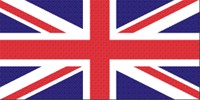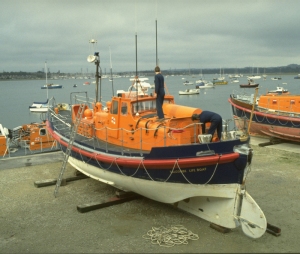For those in peril on the sea….
THIRTY years ago today, the crew of the Salcombe RNLI all-weather lifeboat launched to assist divers in trouble
Little did they know that the day would take a dramatic turn with a crew volunteer going overboard and the Watson class lifeboat capsizing in enormous seas.




All pictures RNLI/Nathan Williams
No-one lost their life despite the incident and last weekend the four crew who are still alive today, met for a special reunion at the charity�s RNLI College in Poole, Dorset.
The Salcombe RNLI crew were called around lunchtime on 10 April 1983 to assist a group of divers who were reported to be in difficulties � their inflatable dinghy had capsized on the Skerries Bank.
As the lifeboat left the harbour it became apparent to the seven lifeboat crew that the conditions were horrendous with ferocious force nine winds and big seas.
Among those who put to sea were Frank Smith, now 66 and at the time the Motor Mechanic at Salcombe lifeboat station and crew volunteers Mike Hicks, also 66, and then a local restaurateur, Roger Evans, 70 now and then an Audiologist and David �Whale� Lamble, the youngest crew member at the time aged just 24 and a fisherman.
The seas had built alarmingly on the day and in the midst of the passage Mike Hicks was washed overboard by a huge wave. Frank Smith takes up the story from his perspective;
�As we turned to go back for Mike the lifeboat started to roll over to starboard. She just had the momentum to carry on. I thought to myself, �I don�t like this� and then I thought �she�s going�. I remember it all going black and then we were upside down and trapped below, everything was the wrong way round. I remember it went very still and I hadn�t a clue where we were. Then I saw a clump of light the size of my fist on the door and that was her coming back up again.�
�When she was back up we turned round to collect Mike out of the water and that meant turning in to the very weather that had just capsized us.�
For Mike Hicks it was a very different story as he recalls with emotion:
�I unhooked my safety line to let someone go by and as I did that a wall of water appeared and I was gone. Then I was going down into the water and I could see two cameos of my sons and I thought �what are you doing down here, let�s go up�. As I hit the surface I noticed my watch was undone. I fastened it and looked over and that�s when I saw the lifeboat upside down and with the propellers still turning. I felt terrible emotion because all my mates were possibly lost. Then I saw the lifeboat come back over.�
�I was looking up at walls of water and then I saw the lifeboat coming towards me, but it got picked up on a wave and then it crashed down in to a trough. There�s a scramble net on the starboard side so on the next run they dropped it down and I came up on a wave and grabbed it and then my crew colleagues managed to pull me onboard.�
David �Whale� Lamble who was the youngest crew volunteer that day, says their RNLI training paid off, it was they all agree �a text book capsize�, but he wouldn�t want to experience it again;
�People often ask me what it was like. I say it was a good experience but one that you would never wish on anyone else or yourself for that matter.�
There were four divers in trouble that day. Two managed to get safely ashore in an inflatable dinghy, while the other two were airlifted from the sea by a search and rescue helicopter crew.
Following the incident a Framed Letter of Thanks signed by the then RNLI Chairman the Duke of Atholl was awarded to the Coxswain and crew in recognition of their fortitude and determination in the �highest traditions of the Institution�. The Salcombe RNLI team included Coxswain Graham Griffiths, Brian �Horse� Cater, Frank Smith, Stan Turns, Roger Evans, Mike Hicks and David �Whale� Lamble.
As designed, the emergency air bag fitted to the 47 foot Watson, had inflated as the lifeboat heeled over beyond the point of no return and initiated her righting. The Baltic Exchange suffered minimal damage but was taken off service for a complete survey and refit following the capsize. Frank Smith recalls that when he took her on trials after the overhaul he found signs attached to most bits of equipment reading �this way up�.
Frank Smith is retired and lives in Salcombe, David Lamble lives near Plymouth and is still a fisherman; Mike Hicks now lives in Brittany and Roger Evans in Scotland.” – http://www.thisissouthdevon.co.uk
Related:
It is 190 years since Sir William Hillary asked the nation to �lend our utmost aid� to those in trouble at sea.
It was an impassioned appeal to the nation, calling for a service dedicated to saving lives at sea, that ultimately led to the formation of the Royal National Lifeboat Institution.
Help those in peril on the sea: RNLI founder’s call still resonates
What drives postmen, engineers and teachers to put their own lives at risk to save those in peril on the sea?
RNLI: What drives these volunteers to put their own lives at risk?
An account of the incredible history of Irish lifeboats, and the even more incredible men and women who are respond in the case of disaster.
For Those In Peril on the Sea
Key facts about the RNLI
The Royal National Lifeboat Institution is the charity that saves lives at sea. Our volunteers provide a 24-hour search and rescue service in the United Kingdom and Republic of Ireland from 236 lifeboat stations, including four along the River Thames and inland lifeboat stations at Loch Ness, Lough Derg, Enniskillen and Lough Ree. Additionally the RNLI has more than 1,000 lifeguards on over 180 beaches around the UK and operates a specialist flood rescue team, which can respond anywhere across the UK and Ireland when inland flooding puts lives at risk.
The RNLI relies on public donations and legacies to maintain its rescue service. As a charity it is separate from, but works alongside, government-controlled and funded coastguard services. Since the RNLI was founded in 1824 our lifeboat crews and lifeguards have saved at least 140,000 lives. Volunteers make up 95% of the charity, including 4,600 volunteer lifeboat crew members and 3,000 volunteer shore crew. Additionally, tens of thousands of other dedicated volunteers raise funds and awareness, give safety advice, and help in our museums, shops and offices.
Learn more about the RNLI
For more information please visit the RNLI website or Facebook, Twitter and YouTube. News releases, videos and photos are available on the News Centre.
Contacting the RNLI – public enquiries
Members of the public may contact the RNLI on 0845 122 6999 or by email.
The RNLI is a charity registered in England and Wales (209603) and Scotland (SC037736). Charity number CHY 2678 in the Republic of Ireland




A recent example of the bravery of RNLI volunteers here:
UK: Pictures released of Bridlington lifeboats in dramatic rescue of four-man crew from sinking fishing boat on Tuesday � 110413 1435z
LikeLike